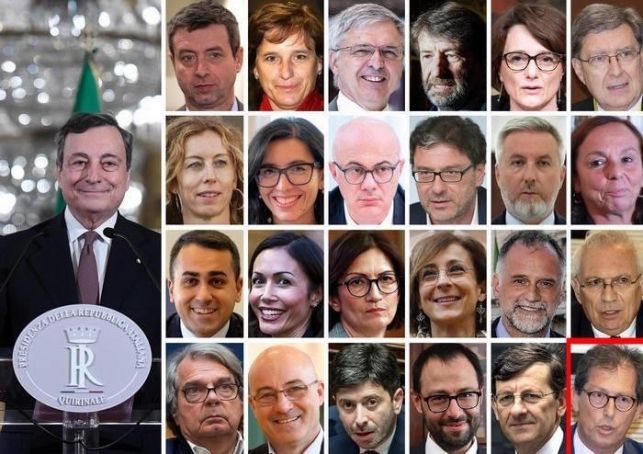Draghi and his new cabinet are sworn in.
Mario Draghi, the former head of the European Central Bank, has been sworn in as Italy's prime minister, in charge of the country's 67th government since world war two, at a midday ceremony at Palazzo Quirinale on Saturday 13 February.
The swearing in of the veteran economist comes after he formally accepted the mandate from President Sergio Mattarella to be Italy's new premier and put together a government following the collapse of the coalition led by Giuseppe Conte.
Draghi unveiled his cabinet line-up yesterday evening, comprising members of all but one of Italy's main parties and covering a wide political spectrum, from right to left.
Eight of Draghi's 23 ministers are non-political technical appointments, while the rest of the cabinet is made up of politicians from the parties supporting the new government.
The cabinet features four politicians from the populist Movimento 5 Stelle (M5S), three each from the centre-left Partito Democratico (PD), Silvio Berlusconi's Forza Italia (FI) and Matteo Salvini's right-wing Lega, and one each from Matteo Renzi's centrist Italia Viva (IV) and the left-wing LeU group.
The line-up gives a stake to all parties except the right-wing Fratelli d'Italia (FdI), which chose not to back Draghi, and means that the new government will have such a majority that no one party will be able to bring it down on its own.

Seven of the ministers held the same positions in Conte's outgoing government including Luigi Di Maio (foreign affairs), Roberto Speranza (health) and Dario Franceschini (culture).
The new team features some familiar faces too, with several ex-ministers from previous governments including Mara Carfagna (minister for the south), a member of FI and former equal opportunities minister; Maria Stella Gelmini (regional affairs), FI and former education minister; and Renato Brunetta (civil service) who held the same position under Silvio Berlusconi between 2008 and 2011.
Several key posts went to technocrats including the new economy minister Daniele Franco, director general of the Bank of Italy; and Roberto Cingolani, a physicist and IT expert, who will head the newly created ministry for green transition; and former Vodafone boss Vittorio Colao, to head a new ministry of technological innovation and digital transition.
Draghi also created a new tourism ministry, separating it from the culture portfolio, to be headed up by Massimo Garavaglia (Lega).
There are eight women ministers in the new line-up. The youngest cabinet minister is Di Maio (34) while the oldest is 73-year-old Draghi.
The main priorities for Draghi and his cabinet will centre around the allocation of around €200 billion from the EU’s recovery funds, and overseeing Italy's anti-coronavirus vaccination programme.
Draghi, one of Italy's most respected institutional figures, is expected to unveil his policy plans in both houses of parliament early next week.
#Quirinale, la diretta video del giuramento del #Governo: https://t.co/R4MK5evLt4— Quirinale (@Quirinale) February 13, 2021




















